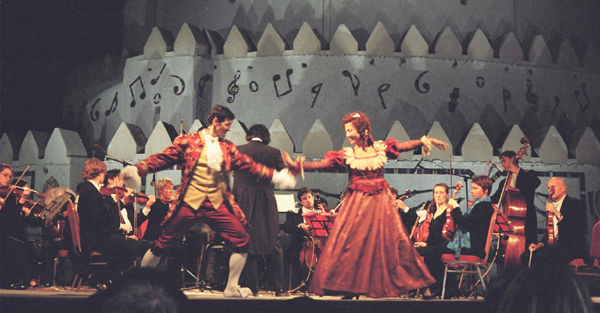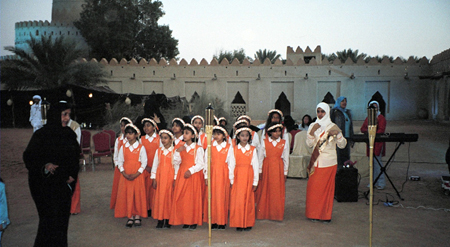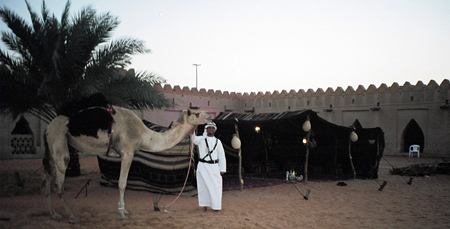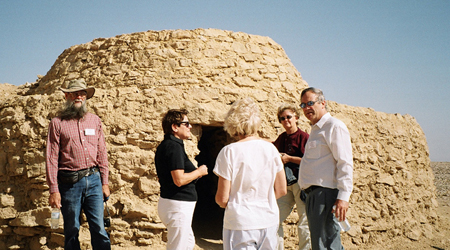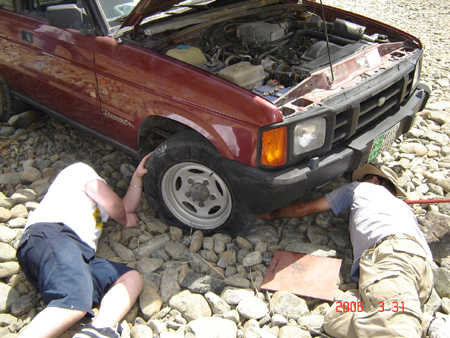
|
|
The 6 th Annual Al Ain Classical
Music Festival
|
|
|
|
Under the patronage of H.E. Sheikh Tahnoun bin Mohammed Al Nahyan,
and thanks to the foresight of the Abu Dhabi Concert Committee,
the 6 th annual Al Ain Classical Music Festival was successful,
enjoyable, and way over the top. Thirty-eight members of The Vienna
Chamber Orchestra entertained well over one thousand guests in
the Jahili Fort on March 8 & 9. The music and life of Mozart were
skillfully presented by Joji Hattori, their Associate Conductor
. The ENHG was proud to participate in the event and provided
guests with opportunities to visit seven different sites-of-interest
in the Al Ain area on both Thursday and Friday mornings. The Hanging
Gardens of Jebel Qatara, always popular, and Jebel Hafeet tombs
were top destinations. Hopefully, as we gain experience, our contribution
to this event will grow even more.
Fifty-six guests took one of seven tours offered
on both Thursday and Friday mornings. They visited Wadi Afrathe,
the Jebel Hafit tombs, Mezyad fort, the Hanging Gardens of Jebel
Qatara, Wadi Aboul, Al Jimi oasis and Afrathe. This year, for the
first time, 4 x 4s were used to transport guests in to the more
inaccessible sites. The consensus was that this was a great improvement
on the previous bus system and hopefully will be expanded next year.
The group may also offer afternoon tours next year, especially if
morning concerts are scheduled.
The highlight of the weekend came when three
of the musicians approached the group requesting an after-concert
tour. The ENHG responded by taking seventeen musicians on the Kaal
to Sharm drive beginning shortly after 2:00 pm. This drive more
than any other takes the visitor through a greater variety of landscapes
and into more archeological sites than other developed tours. We
first stopped off at a rock formation which clearly shows the folding
and faulting that took place millions of years ago over so much
of the region. This is followed by a stop in a sand bowl where camels
take dust and mud baths. The edge of the desert where rock and sand
meet is always interesting. A local camel herder stopped by and
offered camel rides. Next came the drive through the sand dunes
to a small area where fossils are quite plentiful. Many excellent
samples were found. More driving and we stopped to photograph some
dune-side camels, then on into wadi Sharm. Here the old fort and
old stone hole-in-the-ground homes (bayt khaima) really impressed
the group. The beauty of the oasis was more starkly contrasts to
the rocky /sandy surroundings. Finally, sun setting, the group drove
back through Mahda and returned the musicians to the Hilton hotel
where they stayed until 5:00 am the next morning. This was the best
way we could think of to repay the musicians for the pleasure of
listening to them perform the 200+year-old music written by one
of the most outstanding musicians of all time. The most amazing
aspect of Mozart’s music being that he could compose an entire symphony
in his head and then write it all down in one day – let alone that
he wrote his first real symphony at the age of 8!
|
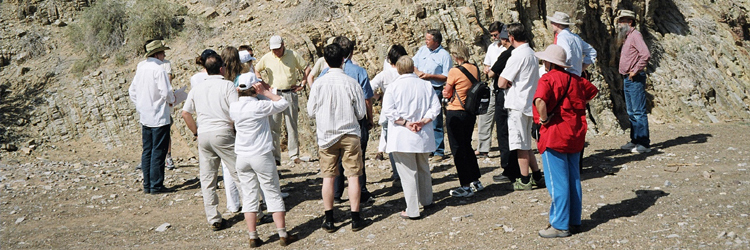 The musicians - on tour
The musicians - on tour
|
|
|
|
|
This broadsheet is published free to families in the Al
Ain area. If you are a member planning an activity with a natural history
theme please notify us so that others can join you. Everybody is able to
contribute to ENHG and Emirates recordings. For more on our activities please
visit our website www.enhg.org or join our e-mail discussion group at enhg@yahoogroups.com.
The Group meets at 7.30pm on the 2nd & 4th Tuesday of the month, usually
at the Intercontinental Hotel. New Members are welcome.
|
|
---------------------------------------------------------------------------------------------------------------------------------
-------------------------------------------------------------------------------------------------------------------------------
| The ENHG
Al Ain Chapter Newsletter…
March,
2006– Issue #233
|
|
Khutwah oasis – some of the plants
you will find there
|
On our walk to the Khutwah Oasis this month we found
a few common plants that you will be able to view in most of the walks
in and out of Buraimi area.
The Sodom’s Apple “Ushar/shakir”
Calotropis procera
The Sodom’s apple is a perennial shrub or tree (250-500cm) that
is found around the UAE. It has a woody base with a rough patchy main
stem, with round to ovoid pale green woolly leaves. It excretes sticky
white latex when broken. But what is so remarkable, are the beautiful
pink flowers found on stalks 1.5 m high. It ranges from a pale pink
to a darker pink. The fruit is smooth and green.
|
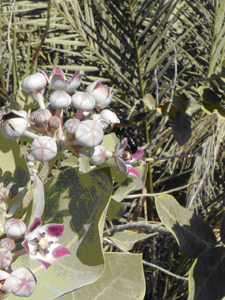 Sodom’s
apple - Calotropis procera
Sodom’s
apple - Calotropis procera
photo by M. Campey
|
|
The Helloborine orchid /Epipactis veratrifolia
It is a perennial creeping rhizome; the stem is covered
with fine hairs, about 80 cm high. The leaves are lance shaped
and alternating on the stems, the flower is on stalks from a leaf
node, 3 petals and 3 sepals green with maroon edges. The petals
curve like wings. The fruit have a cylindrical capsule that is
ribbed, and when it opens up produces tiny brown seeds. They flower
February to April. You will find them on wadi banks and in irrigation
channels in the Hajar Mountain. They are found in combination
with the Maidenhair fern “Adiantum capillus-veneris”
The Maidenhair fern, “sahaba”, Adiantum
capillus-veneris
It is a perennial with fronds up to 30 cm, they have
rooting parts with brown scales. The stems are leafless, with
variations of colors, brown to black. The leaves are oval with
divided lobed leaflets. Spore cases are found on the outer edges.
They have the same habitat as the helloborine orchid. The maidenhair
fern infusions are used for chest diseases, to induce vomiting
and to treat obstructions of the liver and spleen.
|
|
Euphorbia , Euphorbia larica
‘Isbaq/ibriq”
It is a very common plant found on all the walks, a perennial
with erect stem 150cm tall. The younger stems are light green
and change to brown when they grow older. If the stems are broken,
they secrete a milky sap. The leaves are reduced and almost absent.
It has a round fruit with 6 segments and two seeds in each of
the segments. It flowers in November to April
|

Euphorbia - Euphorbia larica
photo by W. Moore |
|
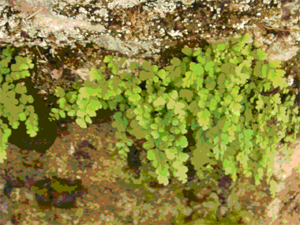 Maidenhair fern, Adiantum capillus-veneris
Maidenhair fern, Adiantum capillus-veneris
photo by M. Campey
|
|
Their habitats are gravel plains and mountain slopes up to 1300m,
in the Hajar Mountains and Ru’us al Jibal. Common uses for the plants
are thatching of roofs, latex for bird catching, poisoning of fish
with plant’s sap. When the plant dies it forms a circle of branches.
|
|
|
|
-------------------------------------------------------------------------------------------------------------------------------
| The ENHG
Al Ain Chapter Newsletter…
March,
2006– Issue #233
|
|
Desert Driving and Desert Survival
|
article & photo by Peter Hudson
|
Desert accidents have two major causes …
1. Poor preparation and planning.
2. Lack of experience.
Having been in, or close to deserts operationally for most of a
decade in the Oman Army and having owned my own camel company I think
I have a reasonable idea of what the topic involves. I also have 10
years experience in The Royal Marines. Much of that was spent in another
type of desert environment; The Arctic.
I have the utmost respect for the desert and for the plant and
animal life that clings to it. To this end I would ask everyone to
take care with its finite resources and to leave it in as good a condition
as when you entered it. Please take all rubbish with you and any that
you see if that’s possible.
Al Ain is on the edge of a huge and dangerous desert; The Empty
Quarter or Rub Al Qali. In summer temperatures reach a brain fuddling,
searing, 55 plus, though it can get cold at night in winter. The desert
however is a beautiful place in which to drive, camp and explore provided
you take some basic precautions.
There must be at least two 4x4 fully equipped serviceable vehicles
and a minimum of two passengers in each. This is just common sense
but also good practical stuff because the number two can spot good
ground; as the driver focuses on the 10 or twenty feet in front of
him the number two assists by relaying the route to take next; rather
like a rally driving duo except much slower
Characteristics of sand
Sand is extremely abrasive: it gets into machinery wrecks your
camera and high tech, ruins optics and gets in your hair and up your
nose. Sand is ok on a windless day but turns nasty with a moderate
breeze and is hell in a strong one. Sand heats up and heats up; the
surface is hot enough to cook food in the summer however deeper down
it is cool. In areas of constant wind it forms dunes and in some areas
these are like small mountains. Sand is like snow forming cornices
and drifts; it is more solid in the morning and in the evening and
night when it forms a crust on which driving is a lot easier. It becomes
very powdery and soft and very difficult after about 11:00 am after
the sun dries it of any surface dew moisture. When it is ground up
by many vehicles ploughing through, the grains become smaller and
a deep powdery track can become very difficult to negotiate like driving
through flour.
Driving is best done when the surface is firmer so you could consider
stopping about midday, get into shade and carry on around 5 pm. For
a “normal” day excursion I would suggest commencing about 6 am and
drive to midday then withdraw or camp up. If you are in the desert
dunes after about 1am you will probably get stuck…in fact you will
get stuck. You should get stuck then you will learn how to get unstuck!
The simplest technique to improve traction in soft sand is let some
air out of each tyre. Two minutes worth is about enough. The rest
has to be learned and done behind the wheel beside a good teacher!
|
|
Swamp
A small note about swampland in the desert: Sabka or bog
is very unpleasant to get stuck in. In summer, areas of lowland
which appear as salty white regions but which fed with winter
rain are some of the most dangerous areas in the world have
been known to swallow vehicles and camels without trace.
|
|
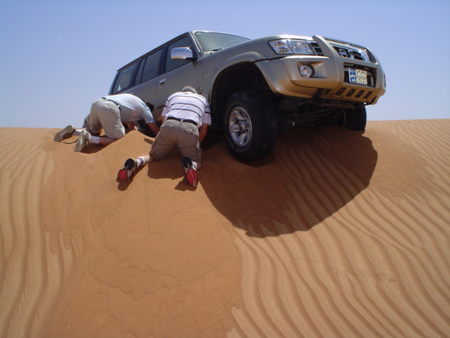 Oops !
Oops !
|
|
|
These are normally marked on maps and don’t worry they are
quite rare but should be avoided in all seasons.
Navigation
Luxury if you have a satellite navigation system and a com-pass
and map. If you don’t, remember that this is the northern hemisphere
so a number of things are standard.
The sun rises |
|
|
|
|
-------------------------------------------------------------------------------------------------------------------------------
| The ENHG
Al Ain Chapter Newsletter…
March,
2006– Issue #233
|
|
Desert Driving and Desert Survival cont...
|
in the east and sets in the west. At mid day it is at its zenith
in the sky and exactly due south. Ok drop a line from the sun at midday
and a line from you to that point on the horizon is due south…so its
easy to fix the opposite direction North and to find East and West.
The moon loops flatter in the sky and it rises also in the east and
sets in the west. Finding south is easy from a crescent moon as you
simply join the points up and project that line to the horizon…that’s
south near enough. Naturally this is dead basic and the other methods
using a watch and thirdly the shadow cast from a stick in the ground
and star navigation are techniques you should learn in practice, not
from a book…as are the fascinating modern techniques with a satellite
navigation system - all includable in the courses I’m hollering about
at the end.
WATER
Water, or the lack of it, is the big killer. The
only thing that works in deserts on the water thing is take
your own and take plenty. In the army, we planned on 5 gallons
a man drinking water per day. That is a full jerry
can each for every day! For anyone who has done arduous training in
55 degrees plus they will tell you…“you just keep pouring it in.”
Don’t be measly with it; this is not the Alamo: drink enough, but
at the same time don’t waste a drop. It’s a sad fact that people have
been found dead in deserts with water still in their canteens. …In
addition to this required load, we all carried over
and above that 4 or 5 full one pint water bottles.
You may need to supplement your potassium supplies as pouring in gallons
of water you may start to go deficient after a few
days. The best way is either with dioralite additive sachets you can
buy at the chemist or what I like better is flat, repeat flat, 7-Up
or Sprite; so pop a half dozen tins of pop in the coolbox!
What you should realize is that no one ever died in the desert
from lack of food. Most of us have about 2 weeks worth, or more, between
our neck and knees. The vital stuff is water.
|
|
 No – you don’t find this out
there waiting for you!
No – you don’t find this out
there waiting for you!
|
|
|
|
Desert Madness
Forget solar stills and fancy gadgets; they don’t work! I have built
10 or more solar stills and never got a drop from any…I did get damned
tired though, digging a flaming great hole each time! Another myth about
finding water in the desert is digging for it… .you
would need a mechanical shovel and a months digging down 30 to 50 feet
or more….i.e. you would die exhausted shoveling soft sand at about 5
feet …but it is true that you are seldom more than 50 feet away from
water in the desert…but it's straight down.
Another no-no, unless you happen to be a plantologist, is chomping
the vegetation…licking stones or swallowing that green gunge camels
regurgitate occasionally. I also tried the clever Bedouin ruse of following
bees!…apparently bees fly towards water, collect it, then fly back to
the bees' nest….after about 20 kilometres I gave up, the bees vanished
and I never saw any water.
So the fact is; you must take sufficient water
with you. Miss this fact and you could die.
Preparation and Planning
It takes at least an hour to gear up a 4x4 vehicle, including checking
and topping up everything, loading and securing all stores.
It is obvious that two or more 4x4 vehicles fully serviced and topped
up with oil, fuel and radiator water are the basic vital requirements.
It also ought to be obvious that a map and a compass should be along
for the ride and a satellite navigation system if you are serious. It’s
a good idea to have a mobile phone, but be advised they don’t work everywhere,
and for anything that uses batteries, you will need recharging facilities
and or spare batteries. Ok so far so good; this is not rocket science.
|
|
|
-------------------------------------------------------------------------------------------------------------------------------
| The ENHG
Al Ain Chapter Newsletter…
March,
2006– Issue #233
|
|
Desert Driving and Desert Survival cont...
|
|
Essential tools and gear
1. Water - loads of water. ( I don’t care how you take it; either
boxes of bottled water or jerry cans or both)
2. Technology: Nav Gear, compass, Map, Sat Nav Communications plus
batteries and recharging gear.
3. You will probably get stuck…take a shovel - at least one per wagon.
4. Take a long tow-rope (20 metre of the nylon flexible - multi coloured
version not the strap type) so you can pull
other vehicles out…
5. Take the spigots and bolts you need to attach the rope to each
vehicle.
6. Complete Wheel Jack and a couple of 2 foot long wooden planks are
useful to shove under the tyres when stuck
or to support the wheel jack.
7. First aid kit.
8. Take a couple of lighters and a big box of matches so you can make
a fire - so you don’t need to do the boy
scout stick rubbing thing.
9. Jerry can or cans of spare vehicle Fuel. Spare engine oil.
10. Vehicle tool box to include spare fuses, hand held tyre pressure
gauge and the usual spanners and spares.
11. Spare serviceable wheel.
12. Foot-pump.
13. Coldbox and contents.
14. Fancy gear worth taking includes folding chairs and table…You
don’t need a tent. You might want to take a flysheet or awning to
attach between vehicles when you stop to act as a sun shade. Oh, and
a big luxury this one a collapsible canvass shower…any daft person
can be uncomfortable… they use amazingly little water …its great after
a dusty day getting to your desert base camp. You need a basic ground
mat, inflatable or otherwise and either a lightweight sleeping bag
or a blanket whichever you prefer. Once again I emphasise - sufficient
full water containers and one for vehicle fuel clearly marked.
|
|
Tell your friends where you are going
Let someone responsible know where you will be going and write it down
for them so they can refer to it later. Put your route on there and
your contact mobile phone numbers and the people who are with your group.
Don’t forget to call them when you return.
Catastrophic vehicle breakdown on your own…
I will not dwell on this worst case scenario but in a catastrophic situation
finding yourself in a single vehicle totally stranded and broken down
with very little assets, no phone etc.
There's a simple ABC for this, it goes something like:
Accept the situation.
- Brew up. Get your pencil out and scribble some ideas down - start
plotting your recovery. If you don’t have a pencil scribe it with
a knife or twig on a flat area of sand. The headings you need to get
your head around are Water, Shelter, Warmth, Signals and lastly food.
- Consider a plan of action.
- Decide.
- Execute.
If you do break down catastrophically and you find yourself on your
own, the book says stay with the vehicle. So lets see…
If you stay put there is a lot you can do to get noticed… A fire is
excellent as it attracts search parties at night and if you burn any
old rubbery stuff during the day you can set up a wonderful tower of
easy to spot smoke. The car seats, the spare, since the vehicle is totally
broken you aren’t likely to need it….and anything else you can get hold
of…green plants give off a lot of smoke too…. The catch-phrase is “Tower
of smoke in the day, beacon of light at night”. The other clever thing
to do is hang, drape, tie anything you can find which shines in the
sun. ”The Christmas tree effect”.
|
|
|
-------------------------------------------------------------------------------------------------------------------------------
| The ENHG
Al Ain Chapter Newsletter…
March,
2006– Issue #233
|
|
A Trip to Wadi Sharm
Fri March 17
|
|
article by Rachel Falconer
|
|
The turn out for this trip was quite small, as most ENHGers were
in Ras Al Khaima this weekend, but there was a good number anyways!
We started as usual at the Buraimi Hotel battling with the flies,
but then decided on our destination point as Wadi Sharm.
Off we went with only Brien and Nasser driving, and stopped at a
few different places first. Stop one was a nice sand dune where
the camels like to take sandy bathes and where one old-growth forest
of Ghaff trees grows. It had just rained 2 or 3 days previous, so
there was a nice blanket of green on the sand too. Then we moseyed
our way on to a grove with some good fossil hunting in it. Mostly
we found uni-valves and corals, but a few unicorn snails and such
were collected too. Brien also showed us a beautiful purple flower
tree that is of the milk vetch type, and grows almost everywhere
in the desert and out my window as well.
Then it was off through the sand dunes and following the awful washboard
road out to Wadi Sharm. Our driver decided to drive alongside it.
Then we stopped in the middle of this open field, (Wadi Safwan)
and Brien tells us this is where we can find old pottery and arrow
heads and maybe some coins too. So the hunt was on for the arrowheads,
mostly 1000 years old or more, and all the guys wanted to find it
It took about 2 hours of
|
|
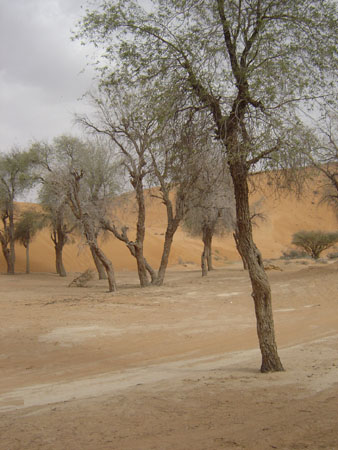
The old Ghaff forest
photo by R. Falconer |
|
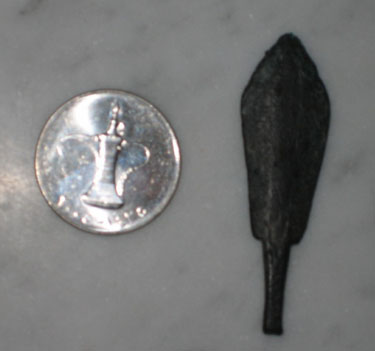 The arrowhead with a one dirham coin
The arrowhead with a one dirham coin
|
|
|
searching to find the first one, after many bits and pieces of
old pots and plates and the like were found first, but we did it,
we found an arrow head. It was definitely a lot harder than it should
seem! But, there it was, in the middle of someone else’s footsteps,
who had walked right over it, but I found it! It’s no more than
1000 years old, and made of bronze, but it’s about 3 inches long,
and still good and solid. So the guys were all a bit jealous of
a woman finding the coveted arrow head instead of a cooking pot,
but that’s ok with me! I’ll be happy to take it in to the museum
for proper archiving, and if they really want me to look after it,
I surely will! Definitely some interesting pieces out there if you’re
into pottery and a great camping site if you’re a weekend adventurer!
I plan on going back to do just that!
So, after a few great finds, and getting totally sunburned on
my neck, we headed off back home stinking and tired, but satisfied
(most of us!) and in desperate need of showers! All in all, a good
day.
|
|
|
|
-------------------------------------------------------------------------------------------------------------------------------
| The ENHG
Al Ain Chapter Newsletter…
March,
2006– Issue #233
|
|
Clean up Day in Madabah
March 31, 2006
|
|
article by Rachel Falconer
|
|
Off it was again early, early today. That’s something I’m going
to have to get used to, is waking up early on Friday mornings, and
going on only one cup of coffee! I will do it for the fun times
I’ve already had getting up that early! There was a good crowd this
morning, I think 5 trucks left today, so not bad for the clean up
effort. So away we went down the main road in Buraimi (as I’ve heard
there are only 2) for about 30 minutes, then a left turn into the
desert, and that’s about as much as I can tell you for directions
to this place! I really don’t know how the guides remember these
things, but I guess if you’ve been going there for a while it sticks
after a bit. So up the wadi we go, after the desert road, and stop
just at the foot of a small pond/river. With a beautiful oasis around
this particular area, I can see why it’s so popular to go there
and have a bite to eat, or just a nice time with friends…… I hope
to go back sometime to do that. However, it was a much needed clean
up today, but also really fun. After climbing your way to the biggest
pool at the bottom and passing many that were so full of calcium
they were absolutely white with it, there was a wall of rock that
needed to be climbed, or you were gonna be left behind!
|
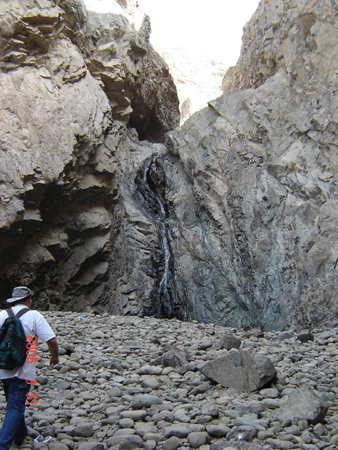 The second waterfall
The second waterfall
|
|
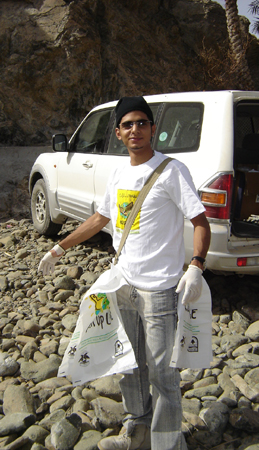
Amer - ready to go
|
|
Myself and a few other ladies stood at the base, hoping that
teleportation would get us to the top, and realizing that wasn’t
going to happen took a deep breath and started up. I’m not so good
with rock climbing as such, but the ascent is ok, it’s the descent
part I don’t like so much. But we all made it, and nothing was broken
or bruised or anything, so we were quite proud of ourselves! After
the climb, you walk into this gully with a beautiful waterfall coming
into the main pool at the top. . Again, a beautiful place to go
have a nice day with special people, and used quite a bit. So the
guys had made it up there first and were already in clean up mode,
and what a satisfying thing to have done today. Of course they used
the clean up as an excuse to jump into the water and get right under
the falls, but they did a great job getting the muck out of the
pool, so it was a win - win situation.
|
|
|
|
-------------------------------------------------------------------------------------------------------------------------------
| The ENHG
Al Ain Chapter Newsletter…
March,
2006– Issue #233
|
|
Clean up Day in Madabah cont...
|
|
It’s a nice shaded area, with some good spots for just relaxing.
And it’s for the most part secluded except for the way in, or from
above, but very quiet and cool with a nice breeze coming in every
so often. So, nose to the grindstone, it was a clean up mission
for most and I ended up being saved by the glove I was given to
use from touching some pretty nasty things, so thanks for that.
And it was a good haul today. I think we got 28 or 30 bags total
of garbage out of the area, and we had a great time doing it. No
sunburn for me this weekend, and I even got a cool shirt out of
the deal. Thanks Jerry for being the guide in this, and for helping
us change the blown tire at the end of it all! What a topper, but
the ENHGers did help quite a bit with that one, and it was a BLOWN
tire with no hope of going anywhere till it was changed! We even
had a bit of background music from Brien’s truck to add to the ambiance!
Another great day, and I’m sure there’ll be many more, even with
the blown tire, but hopefully not ours, nor anyone else’s in the
group next time!
|
|
Hey! This tire's only flat
on the bottom!
|
|
 A very good day’s effort - indeed
A very good day’s effort - indeed
|
|
|
 A tough job made easy with a little water
play!
photo by Gerry Buzzell
A tough job made easy with a little water
play!
photo by Gerry Buzzell
|
|
|
-------------------------------------------------------------------------------------------------------------------------------
| The ENHG
Al Ain Chapter Newsletter…
March,
2006– Issue #233
|
|
Afrathe – a wadi with a difference
|
article & photos by Bob Reimer
|
|
The trip to the cultivations near Afrathe was enjoyed by nine
guests of the music festival including three musicians. The
tour was let by Steve Ehrenberg and Bob Reimer. Steve explained
the tufa formations and pointed out its use as a building material,
particularly in the terrace walls and fences.
Later in the tour, Steve checked the composition of the tufa with
his handy-dandy geologist's flask of hydrochloric acid. Steve
positted that the area would be light in calcium therefore the tufa
would be mainly mangnesium compounds. Much to his chagrin,
the acid frothed indicating calcium compounds.
The oasis was in a good state as dates were being pollinated,
limes and mangoes were in bloom and sidr and pomegranates were in
fruit with one sidr being particularly heavily laden. There
were also many onions and herbs growing. A major surprise was
a large grape arbour. Butterflies, wasps and beetles were
spotted by a number in the group. The faunal highlight of
the trip had to be the male Sinai Agama ( Pseudotrapelus sinaitus
) in its distinctive powder blue mating display, spotted by Martyn
Thornington. The lizard was basking on the tufa and posed
for many pictures.
|
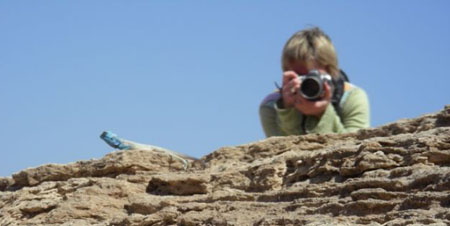 the male Sinai Agama ( Pseudotrapelus
sinaitus) in its distinctive powder blue mating display
the male Sinai Agama ( Pseudotrapelus
sinaitus) in its distinctive powder blue mating display
|
|
|
The group was fascinated by the springs that fed the oasis
and the tiny channels that guides water to the settling ponds.
The tour finished with exam-ining the structure of the ruined
homes to the north end of the area. Some of the bait khaimah
have rock peaks on the back wall reducing the need for poles in
the construction.
|
|

The group exams a sidr laden
with fruit
|
|
|
When planning the trip, I was worried if we would have enough
to do to fill 3 hours. As it turned out, we rushed through
the last few features and still were late back to the hotel.
I think everyone enjoyed the tour of the oasis and its many interesting
features.
|
|
|
|
-------------------------------------------------------------------------------------------------------------------------------
| The ENHG
Al Ain Chapter Newsletter…
March,
2006– Issue #233
|
|
NIZWA /JEBEL SHAMS WEEKEND TRIP APRIL 19,
20, 21
|
|
Well – we have finally finalized the final plan for our trip
to Nizwa – finally! I mean – ok plans A and B got tossed aside,
but I think we’re on G or H now… SO – let’s all register our desires
for this plan by emailing Will (
dreigo@eim.ae – my old email
address) with our names, mobile numbers, email addresses, method
of transportation we plan or hope to use (indicating need or ability),
trip letter (A – the low road or B – the high road), and (let’s
not forget) then phone the appropriate hotels/campgrounds for reservations:
Wednesday night:
The High Road
The Jebel Shams campground has quoted me a rate if 15 Riyals per
night for one cabin (their usual these days is to ask for 15 R per
person per night – includes dinner and breakfast) so we will have
to take our own food and drink up if we want this rate! No more
than 3 people per cabin please unless you are a family unit. This
would be for the Wednesday night, April 19. Thursday night will
be in Nizwa.
The Low Road:
will stay in Ibri for the first night - Ibri Hotel – 0968-25691626
Thursday night :
Both groups will stay in Nizwa – Magan Guest House – 00968-25431912
; or Al Diyhar – 00986-412402
Falaj Daris – say they are fully booked
Please also include any pertinent information regarding
your ability to do the hike on Jebel Shams (previous problems with
heart, lungs, hips, etc.)
We always do our best to travel at appropriate speeds
- if we don’t know you have a problem, how can we adjust for it?
Yer Ed. & Weekend Planner – Will
Moore
|
PHOTOGRAPHY COMPETITION
It is now one month away from the deadline for
entries for our Spring 2006 Photography Contest (May 9th). Rules
and a entry label template are posted at
http://www.enhg.org/admin/photo.htm.
You must be a member to enter, so if you haven't renewed your
membership, Tuesday would be a good day to do it!
Remember that the special category this year is
"Motion." You may chose to interpret "Motion" in any way.
Be careful with your cropping of images. This
is the judges' key piece of advice each year. You can use normal
digital techniques to enhance your photograph just as you could
manipulate a photo in the darkroom. Any obvious cloning though
may detract from your photo.
If you are submitting entries from digital cameras,
I'd appreciate also receiving a file with your entry so that your
submission can be shown at its best in the PowerPoint presentation.
Remember you don't have to wait a month to submit!
One of the photography blogs I follow had a pointer
recently to the the winners of "Pictures of the Year International."
You may want to check out the Natural History categories for inspiration.
Natural History -
http://www.poyi.org/63/01/01.php
Natural History - Story -
http://www.poyi.org/63/02/index.php
|
|
|
|
-------------------------------------------------------------------------------------------------------------------------------
|


